A healthy pet bird is recognized for its smooth plumage, energetic behavior, and clear eyes. Proper care and nutrition are crucial for maintaining a bird’s health. However, more than reasonable care and love from the owner is needed to ensure the bird’s well-being.

Sometimes, you realize that your parrot is sick. It shows signs of apathy. Every day, the bird trembles, sleeps on the perch for a long time, leans on the bars and crests, does not clean feathers, and does not react to sounds. Often, the disease is characterized by refusal of food.
Wavy parrot diseases have specific symptoms, and their treatment is ideally best done in a zooclinic setting.
If you realize that the bird is sick, it is better to adhere to specific rules, compliance with which will prolong the life of the bird and restore health:

As a rule, a wigeon needs additional heating in case of colds, rhinitis, or poisoning. If several parrots are at home, the sick bird is isolated from the others in a separate cage and heated with a lamp at some distance. You can use a unique lamp for heating exotics, as well as an ordinary lamp, which has an incandescent spiral.
First aid for GI disorders is an adsorbent or activated charcoal. Dissolve one tablet in 10 ml of water. Doses for small parrots are four drops three times a day, and for medium parrots, six drops. Give in the beak for three days. For large parrots, you need to dissolve one tablet in 2 ml of water; give 1-2 ml three times a day for three days.
Home-made honey has tonic properties. This method is used by all owners of exotic birds who know how to cure a wavy parrot from a cold at home.
With exhaustion and dehydration, the bird can be given glucose. This supports liver cells that fight intoxication.
The sick bird should be given a calm and quiet place. It needs rest and should receive clean water, fresh food daily, and various vitamin supplements the veterinarian prescribes.
How to give medication to a parrot
The medication is mixed into the feed. It is best to have a veterinarian determine the daily dose individually. This depends on the bird’s age, type, size, and disease. If you treat the bird yourself and it doesn’t eat or drink water, the medicine must be given forcibly through a syringe (with a needle).

The solution is poured through the corner of the beak very slowly so the bird does not choke. The veterinarian uses a probe or intramuscular injection to administer the medicine internally.
Video: How to give medicine to a parrot in the beak
A common disease in parrots: self-plucking and feather eating
This is a fairly common disease in pets in poorly ventilated enclosed spaces. If the disease is neglected, it will be tough to rid the pet of the habit of feather pulling.
Diseases leading to self-plucking:
- giardiasis;
- stress.
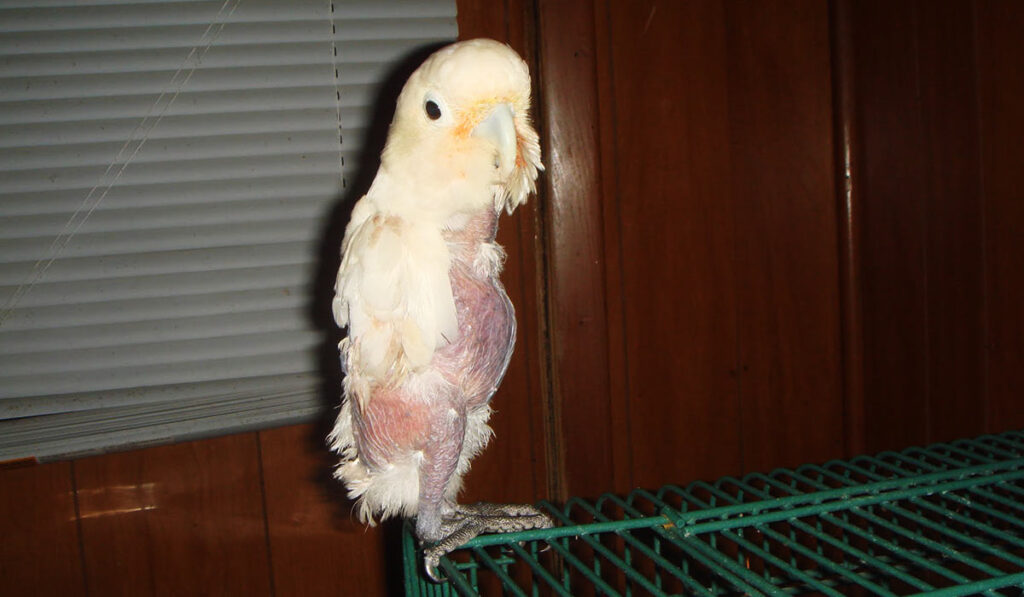
But self-plucking is rarely caused by a single factor. It is often a cumulative problem. Thus, trouble can occur in cases of improper nutrition, insufficient bathing, infringement of the bird’s rights, poisoning, chronic bacterial infections, hormonal surges, food allergies, etc.
You are unlikely to find the cause of plucking yourself, so a trip to the vet is a must. Feather plucking cannot be accompanied by behavioral factors alone. In any case, there is at least one physiological cause!
Beak and claw growth in parrots
Tree branches, mineral stones, and chalk are excellent solutions to prevent excessive claw and beak growth. In advanced situations, a doctor can perform clipping at a veterinary clinic.

Video: How do you trim the beak of a wavy parrot (carefully, if you need more time, do not take it!).
https://www.youtube.com/watch?v=6iksQVj1AoM
Poisoning in parrots
In case of poisoning and dehydration (usually characterized by diarrhea and vomiting), a 5% glucose solution is used: small parrots – 0.2-0.4 ml in the beak 1-3 times a day for a week, medium parrots – 1-2 ml 2-3 times a day for a week, large parrots and birds—4-15 ml 2-3 times a day for a week.
The exact dosage is best discussed with a veterinarian. When self-treating, remember the main rule—do no harm!
Poisoning can be caused by anything from table salt to household chemicals.

Whatever the cause of poisoning, if you observe diarrhea, cramps, and severe thirst in your bird, you should give your pet an absorbent as soon as possible. This will help reduce toxins in the body. The absorbent can be activated charcoal, enterocele, or smectite.
It is also recommended that the bird be heated with a lamp (a table lamp, for example) and that a few drops of citrus juice be added to the drinker.
Frequent vomiting, constipation, and diarrhea in a parrot
Such symptomatology usually indicates the poisoning of the bird. However, pathological vomiting should not be confused with natural regurgitation. If the parrot is poisoned, he begins to burp often after eating. And many owners of feathered birds do not know what to do and what causes this phenomenon.
It could be:
- the result of overfeeding a pet;
- vitamin deficiency;
- improper diet;
- diabetes mellitus;
- hepatic abnormalities;
- peritonitis;
- toxin poisoning;
- parasites.
It is not uncommon for birds to have diarrhea after vomiting. This is the result of salmonella infection. A bird with severe dehydration quickly weakens and may even die. If the parrot has diarrhea and the owner does not know what to do, you should contact a veterinarian as soon as possible.
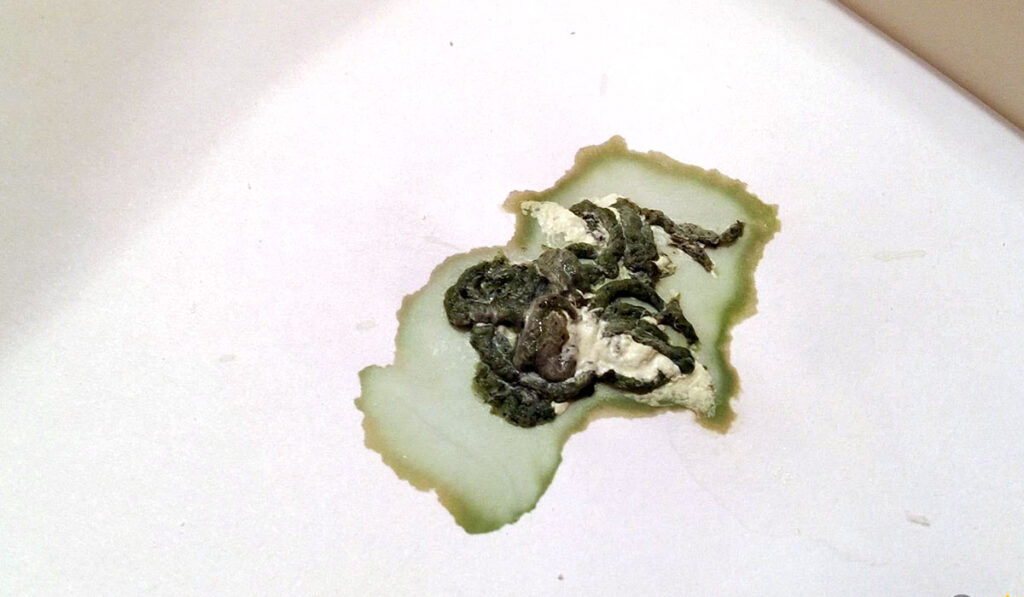
Salmonellosis can be contracted through infected food or dirty water. Symptoms include fever, lethargy, blueing of the beak and paws, and frequent liquid diarrhea of green-yellow color with flecks of blood.
Causes of liquid stools in parrots:
- Micronutrient deficiency, goiter inflammation, fungus, dysbacteriosis, or infection – undigested food is present in the stool as small particles.
- GI disorder, nervous system disease – black droppings with a lot of liquid.
- Kidney failure or arthritis – large amounts of white dots in the stool.
- Poisoning or parasites (liver is affected) – bright green, yellow droppings.
- Overfeeding with fatty food (pancreas is affected) – white-gray droppings.
- The presence of parasites in the liver, micronutrient deficiency – green liquid. You need to see a doctor right away!
- If blood is found in the feces and you did not feed your pet beets, in this case, you should also visit the veterinarian immediately.
Causes of constipation in parrots:
- Poor quality feed.
- Lack of water.
- Stress.
- Dirty cage.
- Eating inedible objects.
- Parasites that cause intestinal bloating.
- Fatty foods.
- The owner won’t let the bird out to fly.
If the parrot is constipated, many experienced parrot lovers advise what to do in this case: pour through a syringe smecta (previously dilute the drug in a small amount of water) and drink 1 ml about once an hour), give liquid food and water.

You can also give 2-3 drops of castor oil or petroleum jelly in the beak. In severe cases, you can try to inject 3-4 drops into the cloaca and massage the tummy. However, it is better to consult a veterinarian to avoid injuries.
To prevent constipation in a parrot, flaxseeds, vegetables, and fruits should be present in the food.
Video: coughing and vomiting in a wavy parrot
Lipoma in a parrot
If your pet parrot has a tumor on its abdomen, it is most likely a lipoma, a tumor mass located on the lower abdomen. Usually, it is a benign neoplasm that grows not only on the abdomen but also on other parts of the bird’s body. It is a subcutaneous ball that moves when pressed. A malignant formation, on the other hand, is practically immobile; on it, the vessels are pronounced.

You can treat lipoma on the abdomen of a parrot only after visiting a veterinarian—the obesity of exotic birds and improper nutrition cause the disease. The disease can be stopped if you put the bird on a diet that includes more porridge, greens, and fruits on its menu.
As often as possible, the bird should be removed from the cage at least once daily. Parrots have no particular lipoma drugs; the disease itself is a common phenomenon. Parrot breeders try to normalize lipid metabolism with the help of a drug intended for humans – Legalon 70.
Video: lipoma in a wavy parakeet
Inflamed goiter in a parrot
If visible goiter in a parrot, for example, as in the photo, then there is inflammation, although, for a long time, the disease in wolfies is asymptomatic.
Causes of goiter include:
- toxic substances that the bird often inhales;
- poor quality feed and lack of vitamins;
- poorly purified water;
- complications from infections.
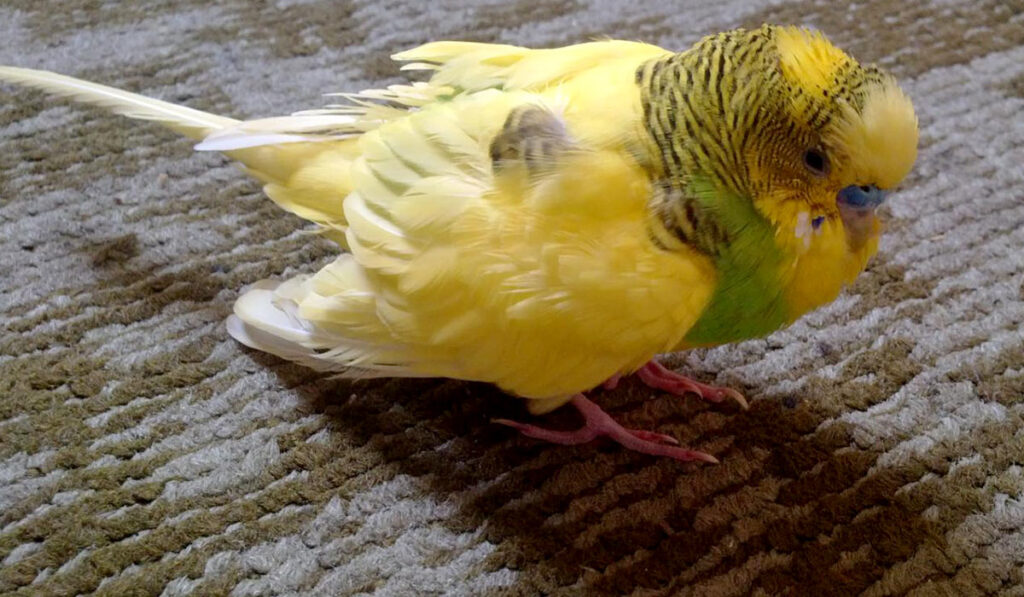
Exotic feathered begins to peck the food poorly, lethargy appears, and the drinking regime is disturbed. Over time, vomiting occurs, in which there are mucous impurities, and the goiter sac itself is inflamed. This is a source of infection and the result of fermentation and congestion. In severe cases, it sags and turns blue.

Only a doctor should treat the disease. Only a specialist knows how wavy parrots get sick and how to eliminate the ailment.
In severe swelling and sagging of the goiter, the sick bird is most often unsalvageable. At the initial stages, the doctor will wash the goiter with a 2% Tannin solution.
Inflammation of the cloaca in a parrot
This disease is characterized by inflammation of the cloaca mucosa. The disease is catarrhal; bacteria cause it due to improper feeding, lack of vitamins, and if the bird is given hard-to-digest food. The cloaca becomes inflamed due to non-compliance with sanitary norms for keeping a feathered friend.
The following symptoms characterize the disease:
- diarrhea;
- Gluing and sticking of feathers around the cloaca;
- inflammation of the skin around the cloaca, swelling;
- general exhaustion;
- refusal to eat;
- decreased activity;
- Occasional bloody discharge or mucus.
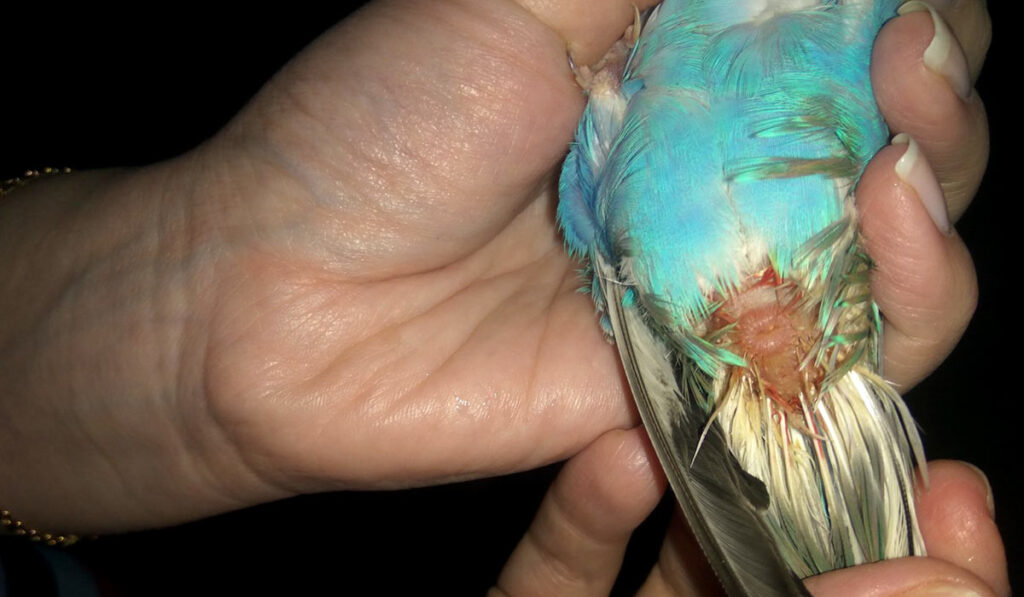
In such a case, saving the bird alone is quite tricky. I think the help of an ornithologist is necessary. You can use it at home to treat the decoction of althea (a teaspoon). Pills with iron sulfate (15g), glycerin (1.5g), and burnt magnesia (2.5g) also have a good effect.
The doctor decides whether to use antibiotics.
Foot diseases in parrots
Owners of feathered animals may face the following problem: What do you do if a parrot suddenly has a sore foot?
This pathology is caused by:
- arthritis;
- sprains, fractures and contusions;
- ulcers on the pads of the paws and toes;
- joint gout.
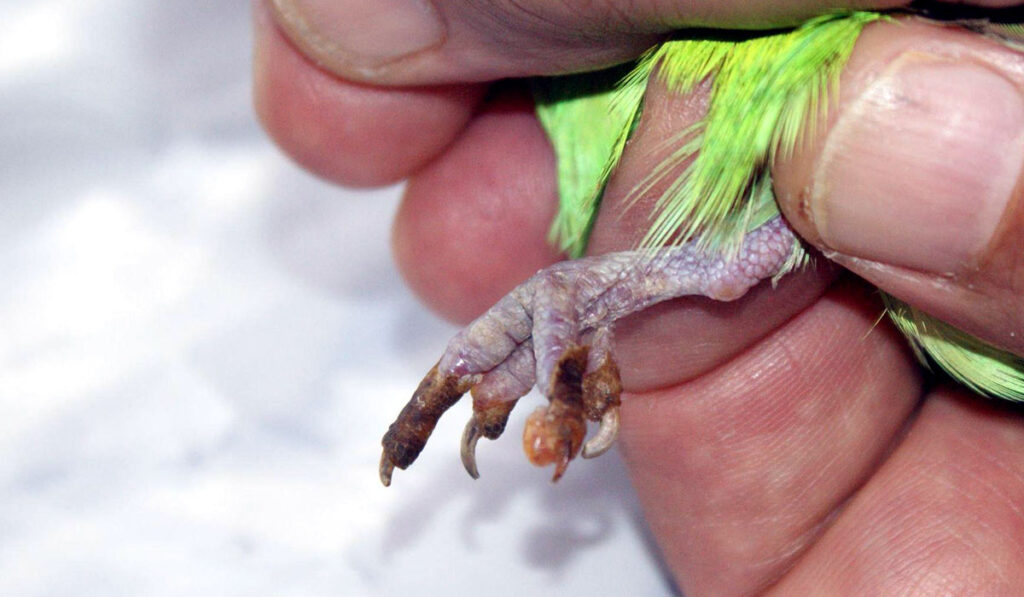
The cause of systemic paw disease can be improper housing or poor diet. If a parrot has a sore foot, what to do – the veterinarian will tell you what to do. Usually, the disease manifests in the form of lameness or wounds and ulcers. The parrot may be limited in movement. If the bird cannot lean on the limb, it may have a fracture.
Treatment of parrot’s feet
If a wavy parrot has injured its foot, only an experienced veterinarian will tell you what to do and how to treat it. Vitamin A in the diet is an excellent solution to ulcers and wounds. If the cage is objectively small, it is better to enlarge it. The affected areas can be lubricated with fish oil and oil with vitamin A. Please pay attention to the perches – the foot should fit on them and not cause discomfort to the bird.
Your doctor will tell you what to do if your parrot’s foot hurts due to a dislocation or fracture. It is better not to take any action alone, as it is easy to injure a delicate creature. The paw will be adequately fixed in a clinic, and treatment will be prescribed.
Mites in parrots
This is one of the most common attacks on birds. Mites pose no danger to humans. A sick bird itches almost constantly. If you pull apart the plumage and look closely, you can see the mites themselves. They can also be found on the legs, near the eyes, or on the beak.
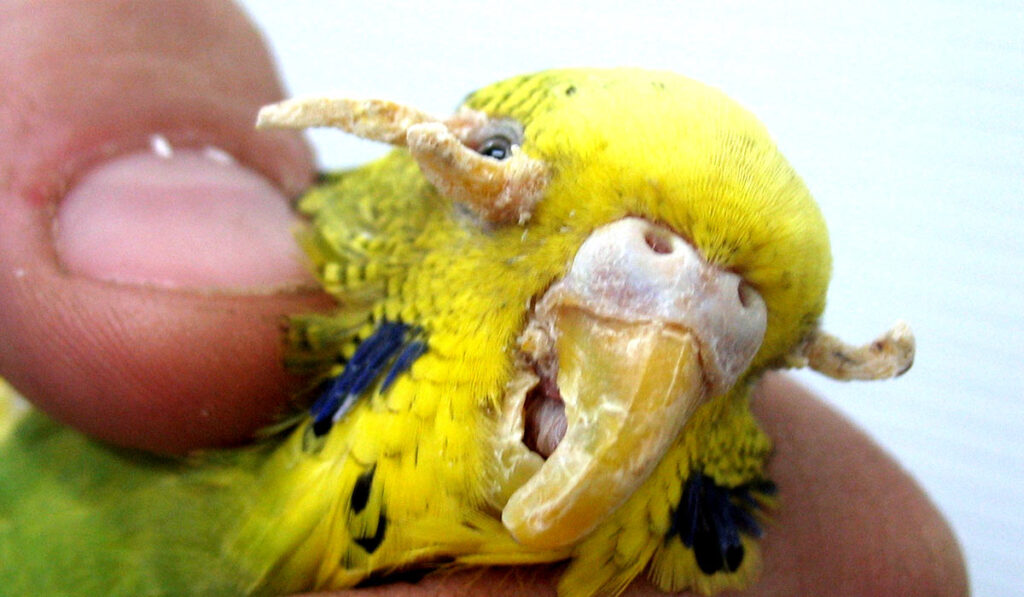
If mites are not controlled, they may form growths on the paws or beak. Vaseline or vegetable oil will help fight these pests, which block access to oxygen and prevent the parasites from breathing, resulting in their deaths. Avermectin or Novermectin ointment can also be used.
Видео: клещи у попугаÑ
Colds in parrots
Parrot diseases can be similar to human diseases. Unfortunately, it sometimes happens that a bird gets hypothermic and becomes ill.
Characteristic symptoms of the common cold are:
- cough;
- sneezing;
- runny nose;
- lethargy;
- poor appetite.
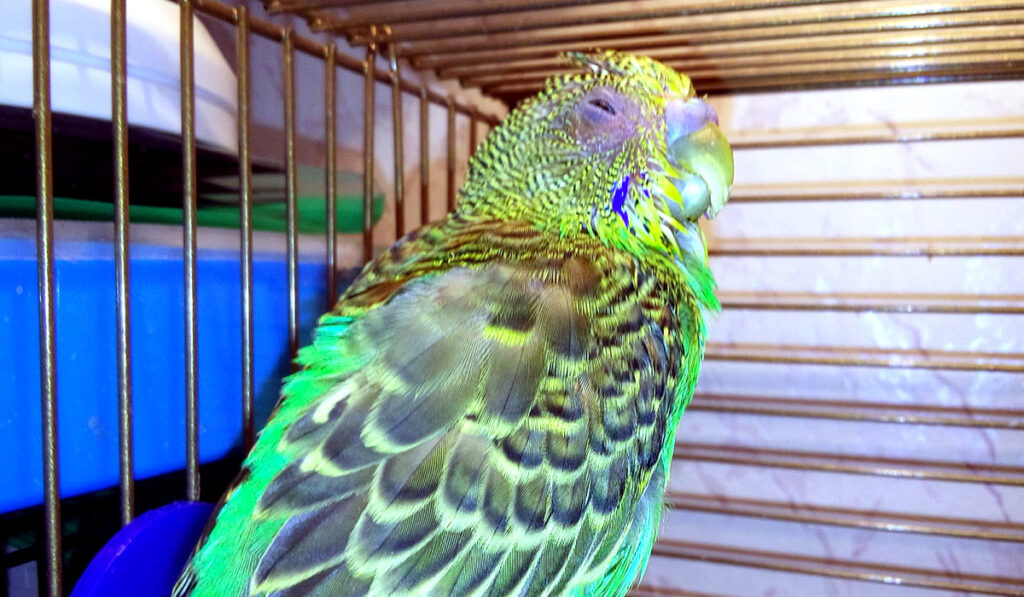
If you observe similar signs, it means that the parrot has a cold. How to treat the pet in this case? First of all, the cage with a parrot should be placed in a warm, draft-free room. With an acute cold, the parrot can breathe with an open beak heavily, there is coughing and sneezing. He should make an inhalation. To do this, dry chamomile flowers are poured with boiling water. Separately, 5 ml of menthol and eucalyptus oil are poured into a bowl. The containers with chamomile and oils are placed near the cage with poultry. It begins to breathe useful vapors. In drinking water add lemon juice, decoction of chamomile or honey to strengthen the immune forces of the pet.
Video: how to treat runny nose in a parrot
All diseases of birds require careful examination and immediate treatment, even in the initial stages. Treatment methods should be applied only after consultation with a specialist, because, unfortunately, in many cases self-treatment can be fatal.




